enrollment
5 Trends That Will Drive Higher Education Innovation in 2020
As the fall of 2019 rolled on, I could not decide if I viewed looking at my inbox each morning with dread or excitement. It seemed that every couple of days one of my many newsletters featured a new data-driven report that had the potential to further “disrupt” American higher education. In almost every case, the news had some implication for the graduate, online, and adult undergraduate sectors with which I have worked over the last 20+ years.
The 2019 Varying Degrees report from the New America Foundation brought all the concerns together in a single table. The report presented survey findings on higher education gathered from 2,029 Americans, and while there were dozens of interesting tables, the one that surprised me/didn’t surprise me the most was one in which all of the generations agreed that there is a serious need for higher education innovation today.
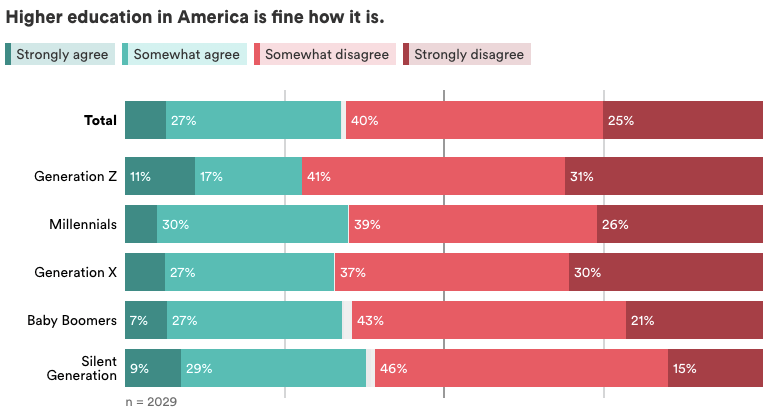
On the surface, the greatest concern is that Generation Z and their Generation X parents feel least confident that American higher education is fine the way it is. While the dim view of higher education by more than 70 percent of Generation Z is distressing, the view of Generation X is even more concerning. Gen X are not only the parents of college-age children, shaping their views of education. They also may be working for two more decades in an economy that demands regular upskilling (see item 5 below), and therefore their lack of confidence that colleges and universities are up to the task matters considerably. The similar views of Millennials—who will be in need of even more reskilling than their predecessors—should concern us all even more.
The following headlines I saw this fall summarized additional trends and the need for higher education innovation find solutions for the challenges they bring.
1. “Enrollment Dropped 1.3% This Fall. Not Every State Tells the Same Story.”
So said The Chronicle of Higher Education on December 16. The story featured data from a new report from the National Student Clearinghouse: Current Term Enrollment Estimates–Fall 2019. The report indicates that for-profits were hit hardest (-2.1 percent) followed by two-year publics (-1.4 percent). It is a sign of the strong economy that these institutions, which have typically served large proportions of adult/nontraditional students, are in the worst position.
Not all regions have been affected equally. There was growth by as much as 4 percent and contraction by as much as 8 percent. This map from the Chronicle shows vast swaths of the country experiencing fall enrollment decline.
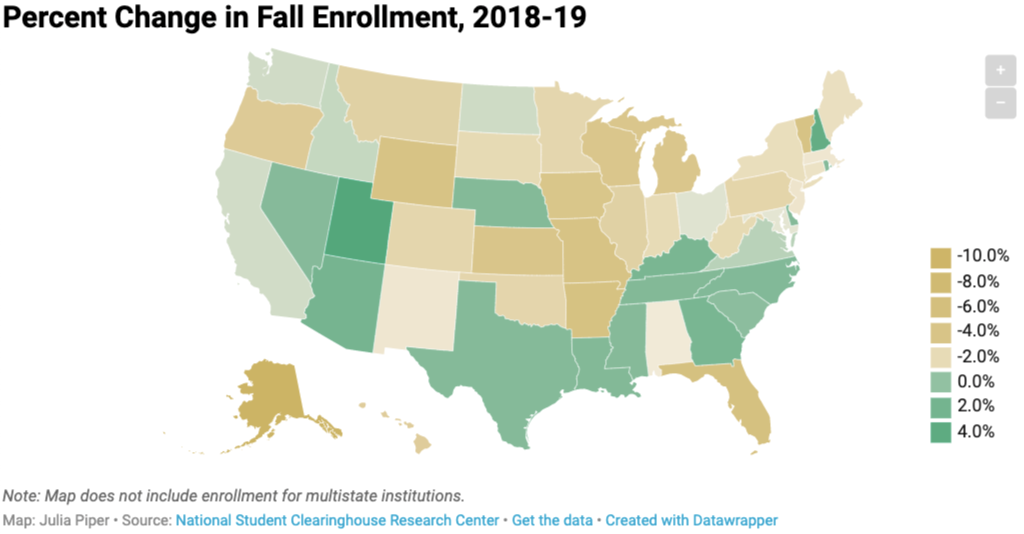
2. “More Students Study Online, But Rate of Growth Slowed in 2018.”
I took issue with this headline. While the rate of growth among students taking some courses online—but not ALL courses online—slowed to 3.5 percent compared to 6.7 percent in 2017, the rate of growth among students enrolled in fully online study continues to grow. 2018 saw growth of 5 percent compared to 4.2 percent in 2017. These data demonstrate that in a year when total enrollment declined, demand for online education grew. There are now more than 3.3 million students engaged in fully online programs, representing 14 percent of undergraduate enrollment and 31 percent of graduate enrollment. Facilitating the growth of online enrollment will be one of the most important areas of higher education innovation in the coming years.
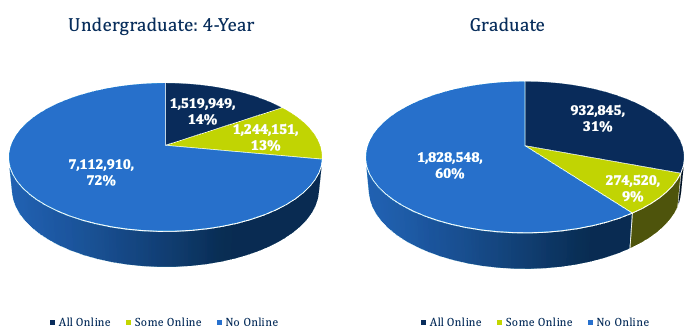
3. “More Ominous Signs for MBA Admissions.”
This headline blared from Inside Higher Education on November 11. The story featured data from the latest Applications Trends Survey Report from the Graduate Management Admissions Council (GMAC). The report indicated that a 3.1 percent decline in overall graduate-level business applications was driven by a 6.9 percent decline in MBA applications—the first year of decline after decades of growth. However, it was not all bad news: applications for other business programs (most frequently finance, data analytics, and management) were up by 5.9 percent. Because other master’s programs only comprise about one-third of all applications, this growth didn’t have a greater impact on the overall fall enrollment situation.
These data align with findings from the work that I do to help institutions understand the market position of their programs. In every region in which I conducted a study in 2019, I found that there were significantly more MBAs being produced than jobs that are typically filled by individuals with such a degree (using the “crosswalks established by the US Departments of Education and Labor). This is one of many indicators likely causing a decline in interest with enrolling in such programs among prospective graduate students.
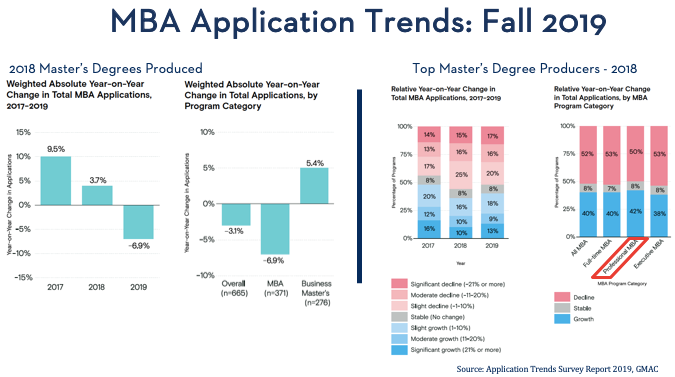
4. “Why Stopped-Out Students Reenroll.”
On Halloween I was thrilled to read on Education Dive that the National Student Clearinghouse (NSC) had updated its research on the “some college, no degree” adult undergraduate population. This new report tracked the continuing educational journey of 29 million students identified in a 2013 study.
The result was a roadmap for institutions that want to focus their efforts on this population. The report also identified 6 million more “some college, no degree” students, making the total population almost 36 million. While this is a huge target, NSC learned that those with 2+ years of past study (10 percent of this population) were significantly more likely to not only reenroll, but also to complete a credential (something I blogged about previously). So, while this defines a more realistic—and smaller—addressable market of 3.5 million, the data throughout the report provide the underpinning for tactics to tighten institutional efforts to recruit these students.
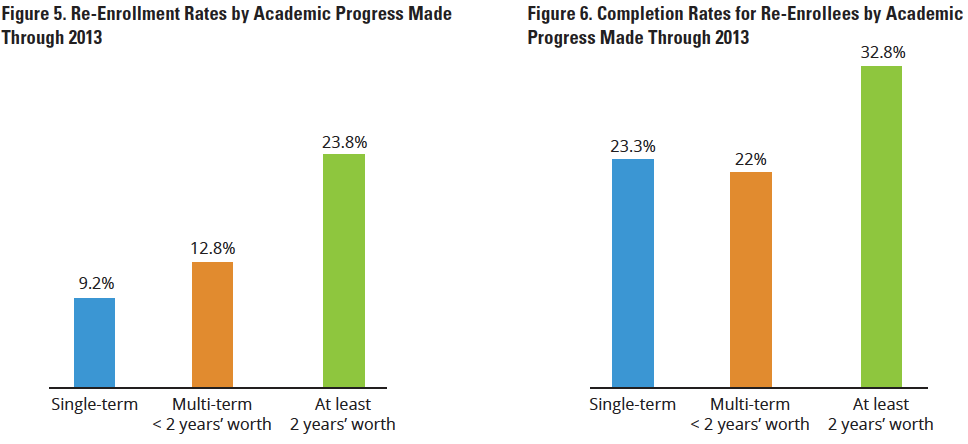
5. “By 2022, No Less Than 54% of the Workforce Will Require Significant Reskilling.”
As I read an excellent monograph in December by Susan Aldridge (recently retired president of Drexel Online) on Educating the Next Generation Workforce, I was thrilled to come across a reference to The Future of Jobs Report 2018 from World Economic Forum (WEF). Most of the reports on the relationship between higher education and workplace skills focus on the long-range future—as far as 2050. In contrast, the WEF report, based on a survey of hundreds of human resources executives, focuses on just the next five years. As the headline indicates, the report states that no less than half of jobs that exist today will require significant reskilling and regular upskilling. Additionally, by 2022, 27 percent of all positions will be new roles that did not exist in 2018. (This also shows the urgency of higher education innovation in the immediate future.)
While technology changes will inherently drive employer demand for a range of tech-related skills, when asked specifically about the skills of the future, survey respondents cited a variety of tech AND critical thinking skills. Perhaps the most alarming aspect of this report is that no more than 63 percent of surveyed organizations see higher education as the preferred provider of the re/upskilling that will be required for their employees. We have long thought that employers were contracting with alternative providers because they could not afford to work with higher education, but this reports makes it clearer that many organizations likely prefer working with the alternative providers.
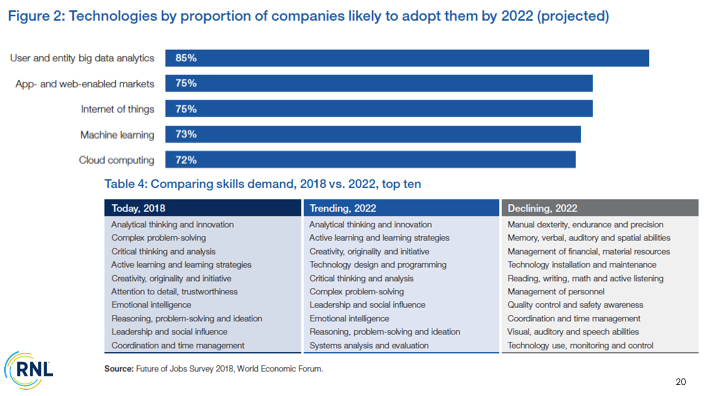
Conclusion: The need for higher education innovation is now

After reflecting on these and so many other findings this fall, I was left with a sense of hope. From my work conducting market research to help institutions ensure their programs and services were “mission ready” to serve undergrad adults, working graduate students, or online segments of these populations, I know that there is a will to innovate at American colleges—particularly when their backs are against the wall.
However, it’s imperative for institutions to innovate before there is a crisis. The best way to do this is to gain an in-depth understanding of what your regional “market” demands of the institutions in which they enroll, then engage in serious discussion with campus stakeholders about how to balance market demand with institutional mission, and then make expeditious decisions to innovate. There is not a moment to waste.
What can you do to spur innovation now? I invite you to talk with my colleagues about strategies and solutions that can help you not only reach your goals for enrollment, but better serve students at all levels. Contact us today to schedule a time to talk.